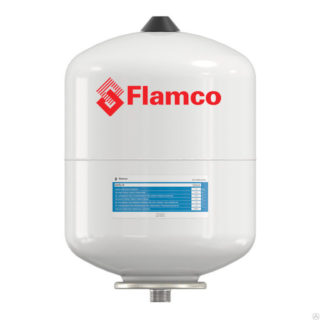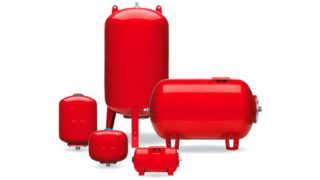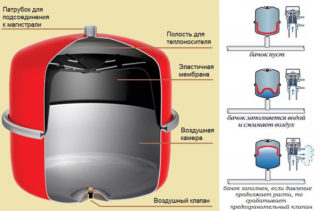Any private house needs a stable, trouble-free water supply system, with a normal water pressure in the taps. It would seem: laid pipes, connected a pump for water supply - and use it. But it’s not that simple.
Firstly, when the water is turned on and off, the pump will constantly work and quickly fail. Secondly, when the tap is closed, the risk of water hammer - a sharp jump in pressure in the system - and possible rupture of pipes and their connections, damage to the connected plumbing equipment (washing machines, water heaters ...) increases.
In order to avoid such troubles, it is necessary to use equipment such as an expansion tank in the water supply system. What it is?
Types of expansion tanks by purpose
- For heating. Designed for high temperatures (up to 120 degrees) and pressure range (up to 4-6 atmospheres), typical for heating systems; made of materials not suitable for drinking water. Usually red.
- For water supply. It is made of materials that take into account the hygienic requirements for the quality of drinking water (rubber or rubber based on ethylene-propylene, steel). The working pressure should reach 12 atmospheres, the operating temperature - up to 80 degrees. Usually blue for cold water (white for hot water).
Tank types
- Open tanks. Installed on attics, roofs of buildings. The water pressure in the system is determined only by the installation height.
- Closed tanks - with an elastic partition (membrane), which divides the capacity of the device into two parts: for filling with water and for air.
Types of closed membrane expansion tanks
- as a rule, these are containers of small capacity;
- if the diaphragm fails, it will be impossible to replace it;
- used mainly in heating systems.
With replaceable diaphragm - balloon type (balloon is also called "bulb"). Optimal for plumbing for the following reasons:
- water enters directly into the pear membrane and does not come into contact with the metal walls of the tank; accordingly, corrosion does not occur and the quality of water does not change;
- the pressure necessary for the functioning of the system is easily injected;
- the membrane is easily replaceable;
- devices of this type can have a high capacity, which is very important for private households.
Expansion tanks used in the water supply system are also called hydraulic accumulators - this is due to their role in ensuring the functioning of an autonomous water supply system in houses.
The principle of operation of a hydraulic accumulator for water supply
With a large flow of water from an autonomous water supply, the pump will work constantly, providing a point of consumption of water directly.
The operating parameters and the volume of the expansion tank, as well as the settings of the control sensors connected to it, are calculated according to certain formulas based on:
- pump characteristics,
- pipeline installation project,
- operational requirements of the equipment connected to the water supply,
- estimated water consumption (how many people will use water, how often, in what volume),
- number of storeys of the building.
The role of the expansion tank
- The expansion tank helps create in the water supply system enough stable working pressure, at which the optimal water pressure will be maintained both for the operation of all plumbing fixtures (water heater, washing machine, flush cistern), and for comfortable use of tap water. The indicators of the required pressure in the air chamber of the accumulator are calculated for each of the autonomous water supply systems according to certain algorithms.
- Creates a supply of water and maintains a stable pressure in the water supply for a certain period of time. There are frequent power outages: in this case, the pump stops working and then the accumulator acts as an emergency reservoir, from which water will flow for some time under pressure. In order to increase the supply of water in the house, you can additionally connect another expansion tank without dismantling and replacing the already installed one.
- Optimizes pump function: reduces the number of times it is turned on. The larger the volume of the accumulator and the higher the maximum preset pressure threshold in the tank, the less often the pumping equipment will operate. Thus, its wear rate will be significantly reduced.
- Plays the role of a water hammer damper... With any start of the pump, there is always a sharp jump in pressure in the water supply system - sometimes it reaches ten atmospheres. The result of such a sharp drop can be a rupture of pipes and fittings, valves; connected plumbing equipment and instrumentation may fail. In this case, the expansion tank takes the shock load on itself: it dampens the wave force - and the system is safe.
In cases where there are risks of exceeding the design pressure with a water hammer of 20 bar (maximum allowable value), it is necessary to install the pipeline in such a way that a separate damper tank can be installed in some of its sections for reliable protection against water hammer.
So, the expansion tank (accumulator) in the water supply system protects it from water hammer, ensures the correct operation of all equipment and household appliances connected to the water supply system, and creates a reserve supply of water.











